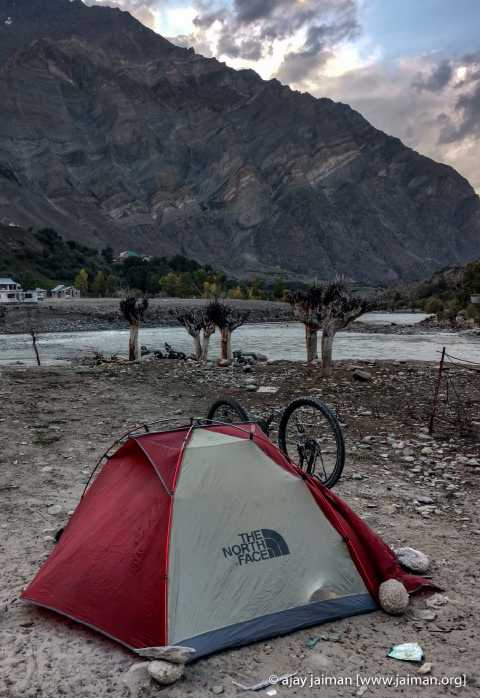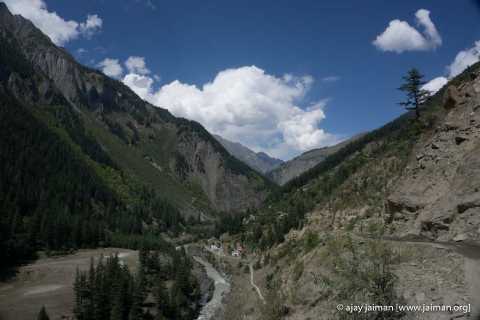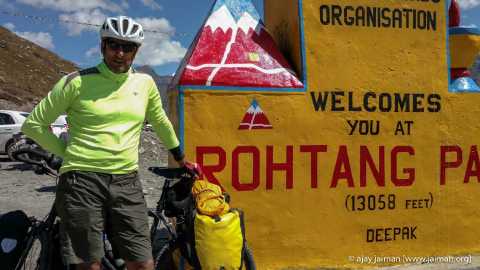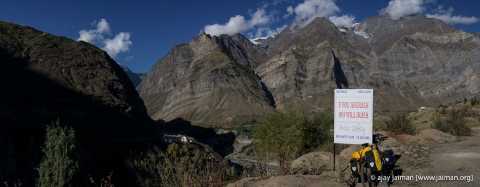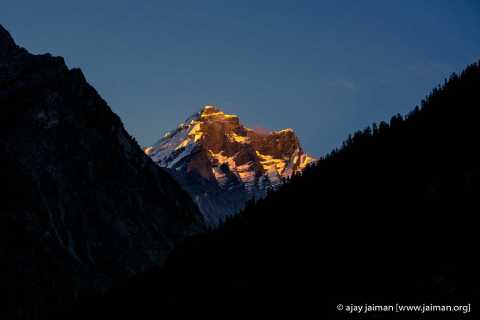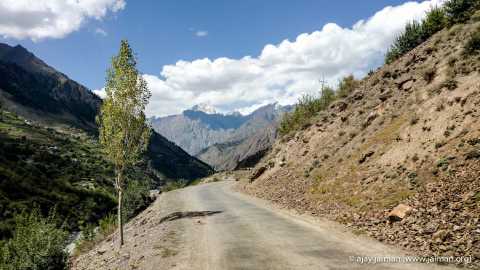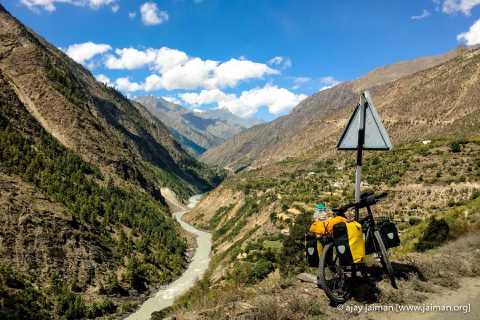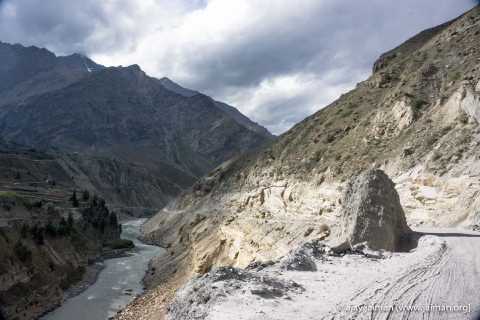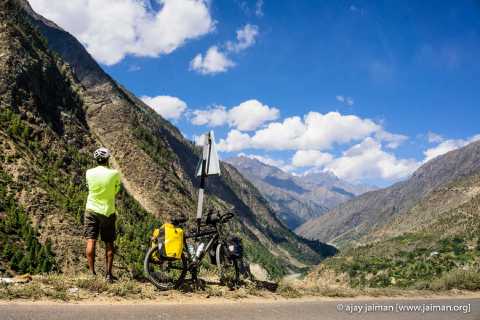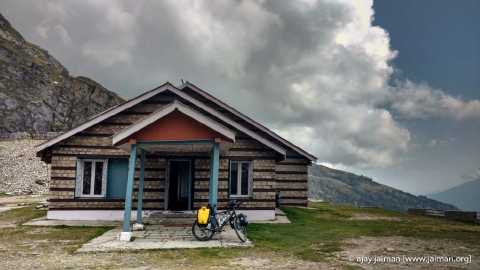At 4,420 meters Sach pass is not among the highest ‘motorable’ passes in the country, but it is certainly one of the steepest and one of toughest to bicycle across. A couple of years ago, Punit and I failed to cycle across it (read about the last attempt to cycle across the Sach pass here. What are the chances that I’ll do better on a solo attempt?
It is a little after 4:00 pm and it has already been a tough day of cycling. I still have the energy to push along for a couple of more hours, but am not sure if that would be good enough to get me to Bagota (no, not the capital of Colombia, but the little tarp cluster short of Sach Pass in Himachal Pradesh). Not finding shelter for the night at this altitude and in these inhospitable conditions is not an option. Time to stop cycling, catch my breath and assess my situation.
I have fallen behind on my schedule. I expected to reach Bagota by early evening. The condition of the road, if you could call it a road at all, the relentless steep gradient and the incredible head-winds made progress much slower than I had anticipated. Sometimes the headwind was so strong that it drowned me in plumes of dust and at one time I even lost my balance. Because the gradient was so steep — over 15% in many places— I just had to get off the bike a number of times and push, and that makes progress even slower. Remember, I am fully self-supported and solo. So I have to carry a tent, cooking gear, sleeping bag & mat and the rest of my personal stuff — a little over 20 kilos, I’d reckon.
In these parts, once the sun goes behind the mountain it very quickly starts getting chilly. And at this altitude it would be imperative to be under shelter before night falls. As the evening approaches I can sense that even by pushing harder I am not going much further. I grudgingly accept that I will not make it to Bagota before sunset. The next best option would be to make camp as soon as possible. Unfortunately, I was stuck in a very narrow valley with a steep cliff on one side and an even steeper valley on the other. The so called road, being chiseled out of the rock face, is not even wide enough to take two vehicles — forget about finding the space to pitch a tent.
The other little challenge I have is water. I have totally run out of it, and would definitely need it for drinking and cooking. I figured that I could possibly push forward for another hour in search of water and a campsite. And if I did not find one in that time I’d need some desperate measures — exactly what, I was not sure.
I would have gone on about half an hour when I noticed a place just off the road where I could possibly pitch my tent without endangering myself or anybody else. I could see it would be hard to pitch camp and to stay the night on this little exposed ledge, which was already being buffeted by high winds. But this was the best place I had found. I figured that once I manage to pitch the tent in the heavy wind, I would have a level of protection from the elements.
Going in search of water in the dark seemed more unpleasant than pitching a tent in the dark so I decided to sort out my water problem before pitching the tent. I could hear a stream at some distance, the question was how to get to it. I left the road and would have walked perhaps a couple of hundred meters towards the stream, when I realised that there was no easy way to get to the water. A misstep in my cycling shoes could take me a couple of hundred feet down. And with no one watching my back I thought it wise to not take any risks. I reckoned, in the worst case scenario, one night without water would be hard but better than falling off a cliff.
I get back to the bike and realise that I need to somehow live through what will be a very unpleasant night, to say the least. I will be cold, thirsty, hungry and miserable, but I’d get to see the sun rise again.
Where I’d find the energy to start riding the next morning was something I was not worrying about right then. I was fixated on getting through the night.
You must wonder, how I got myself into this royal mess. So let me start from the beginning.
Earlier this year my brother and I registered ourselves for the MTB Himalaya — considered one of the toughest MTB races in Asia. Neither of us are racers, but somehow whenever we get together we end up doing stupid things. We did know that we’d need to work really hard through the year to get to the fitness level to even finish the race. That, as you’d expect, did not happen. Because, well, life happens. So couple of weekends before the race was due, I decided to up the ante and go on a high-altitude solo ride in the Himalayas. That should get me acclimatised to the altitude and get the ball rolling, or so I thought.
I took a night bus to Manali and spent the day assembling the bike and riding around town. I slept early hoping to leave early next morning.
Day 1: Manali to Marhi:
I get up early and get ready. But I cannot leave just yet — it is raining outside even as all my weather apps tell me that it is “Bright and Sunny”. Fortunately it clears up by late morning and I leave for Marhi. Rest of the day is rather uneventful, I do not get any more rain and I ride up to Marhi with ease. I decide not to camp but sleep in the forest rest house instead. It looks very interesting from the outside, but is quite bare inside — the caretaker tells me that it stays buried under snow for many months of the year.
Day 2: Marhi to Tandi Bridge:
The last time I rode up to Rohtang I remember feeling crushed so I start out braced for a tough ride. Surprisingly the ride up to the pass gets wrapped up very easily and quickly. The fact that the quality of road has really improved makes a big difference, but perhaps over the years, I have become a little better too. I had originally planned to sleep in Sissu, but I am there by lunch, and it makes no sense to stop yet. I have a quick lunch and continue on. Just short of Keylong is the Tandi bridge sitting at the confluence of the Chandra and Bhaga rivers, and also the junction where I leave the Manali-Leh road and follow ChandraBhaga towards the Pangi valley. I have an early dinner and make camp right next to the river.
Day 3: Tandi Bridge to Tindi:
Once you leave the main Manali-Leh highway the road rapidly deteriorates. Very soon you lose sight of the road itself. You are on a narrow dusty-rocky trail masquerading as a road. Every time a vehicle passes in either direction it drowns you in dust. Fortunately there is not much traffic and it further thins out after Udaipur (yes, Udaipur of Lahaul). After a rather big lunch at a dhaba in Udaipur I decided to not stay the night there hoping to reach Tindi before nightfall. By the time I reached Tindi it is kind of late to find a place to camp. Turns out that Tindi has no private accommodations, and the PWD rest house is booked for the District Commissioner. I get permission to camp inside the sprawling PWD campus. The caretaker offers me the use of the rest house bathroom since the DC is not expected till later at night. We eventually get word that the DC won’t be coming so I get access to his well-appointed room. Nice!
Day 4: Tindi to Killar:
I had figured that day 3 and 4 would be relatively easy since I would mostly be going downstream with the Chenab River, but it was not so at all. The road keeps climbing up and then going down again, with roughly 1000m of climb everyday. Today it turns out to be even more because Killar sits perched on a hill so the last couple of kilometres are a steep uphill. The town itself, perhaps the biggest in this valley, is sleepy and quiet. There are two main hotels in this town - the Raj and the Chamunda — the first one is supposedly the fancy one. Which translated into higher than normal room rent for very basic facilities and even more expensive room service.
Day 5: Killar to Bagota:
After four long days of cycling, I really longed for a rest day. Unfortunately I was running a tight ship — the plan was to get to Bagota so that the next day I could get to Bairagarh on day 6. And day 7 was meant to be a long downhill to Chenab and eventually leading to a night bus to Delhi. I had to be in Delhi to pick up my brother from the airport and then go to Shimla for the MTB Himalaya. Everything had been planned! And you know what happens to finely laid plans.
In hindsight I should have started from Killar very early in the morning. I realised later that two full days are not enough to get to Bairagarh from Killar, especially if you are fully-loaded and self-supported.
The first 10 odd kilometres out of Killar is a steep downhill to the river Chenab. Once you cross the river the climb starts. There is no build up… it just hits you in the face — steep 10 to 15 per cent grade over rocks, rubble and dust. The road isn’t even wide enough for you to try and snake up. So you push and push hoping not to get off the bike, because once you get off, getting back in the saddle on such steep inclines is very hard. Once you get off the bike you have to walk the rest of the steep incline till you get to a less extreme section.
There is not much traffic you encounter here, but mostly they are Tata Sumo, and an occasional Scorpio or a small truck. This is mostly 1st gear terrain even for jeeps. The progress for all vehicles is extremely slow.
Around lunch I pass a little shack from where a lady runs a dhaba. She is part of the famous women’s only satsang group, and ensured that I digested the wise words of her guru while I gobbled down my food.
After many more hours of riding and pushing it seems as if I had not made much progress. As the sun starts to go down I begin to realise that Bagota is not going to be achievable. Not tonight, at least.
So there I am processing in my mind, the need to spend the night without food or water, huddled in a tent on a windy ledge. What is of even more concern is how I will restart riding tomorrow. And how will I make up for the lost time while being thirsty and hungry — remember, I am on a tight schedule.
After I sit down for a few minutes I realize that this trip is not going to get done as per plan. There is no way I am going to ride all the way up to Bairagarh tomorrow. So I’ll have to hitch a ride in a jeep at some point of time to get to Delhi as per schedule. Once that clarity is reached, I just have to hunker down and deal with the night. I am sure I’ll get a jeep in the morning — no vehicle has crossed me in a long time and I do not expect anyone to pass now, because anyone who crosses me now will reach the top after dark — not very wise.
Just as I am mentally preparing myself for a long cold night I hear a jeep. I notice that it is not even full. Turns out that it is on an ambulance run. The patient in the back seat needs to get to the hospital urgently. I readily take their generous offer for a ride.
As I sit in the car though, I think about how I am feeling about abandoning my second attempt to ride up the Sach pass. Interestingly, it does not feel so much like a failure, but like a valuable life experience. They say you should never get into an ego tussle with the mountains, the mountains always win. Anyway, the mountains aren’t going anywhere, they will still be here next year. And the year after… So I need to go back for a third attempt.
Later that night, the taxi driver halts at Bairagarh, ostensibly for a quick dinner. While we are there the patient’s attendant requests the attention of a local doctor. In that small village/town the doctor arrives very quickly, but unfortunately he can do nothing except pronounce the patient dead. The driver gently takes me aside and politely tells me that my ride is over, since they will now be turning back. And there I am, standing on a quiet street corner of a nondescript town and wondering at the strange and mysterious ways of life. And death.
First published on October 1, 2016
#cycling, #adventures, #featured, #cycle touring, #cycling in the himalayas, #himachal pradesh, #saach pass, #self-supported cycling
You may also be interested in these related posts:
Cycling across the Sach Pass, Himachal Pradesh
Which is the best cycle for touring the Indian himalayas?
Cycling the Spiti valley — Nako to Manali
Riding the thunder dragon
Choosing a bicycle 101: Roadie, Hybrid, MTB, Touring or fixed gear?
